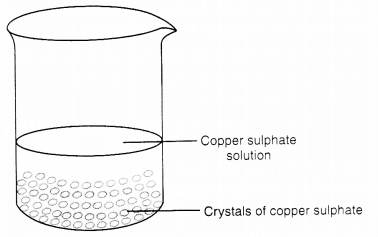NCERT Solutions for Class-7 Science Chapter-6 Physical and Chemical Changes
1. Photosynthesis
2. Dissolving sugar in water
3. Burning of coal
4. Melting of wax
5. Beating aluminium to make aluminium foil
6. Digestion of food
Answer:
1. Chemical change
2. Physical change
3. Chemical change
4. Physical change
5. Physical change
6. Chemical change
(a) Cutting a log of wood into pieces is a chemical change. (True/False)
(b) Formation of manure from leaves is a physical change. (True/False)
(c) Iron pipes coaled with zinc do not get rusted easily. (True/False)
(d) Iron and rust are the same substances. (True/False)
(e) Condensation of steam is not a chemical change. (True/False)
Answer:
(a) False
Correct statement: Cutting a log of wood into pieces is a physical change, ft, False
(b) True
Correct statement: The formation of manure from leaves is a chemical change.
(c) True
(d) False
Correct statement: Iron and rust are two different substances.
(e) True
1. When carbon dioxide is passed through lime water, it turns milky due to the formation of …….
2. The chemical name of baking soda is ………
3. Two methods by which rusting of iron can be prevented are ……. and ……….
4. Changes in which only ………. properties of a substance change are called physical changes.
5. Changes in which new substances are formed are called ……. changes.
Answer:
1. calcium carbonate
2. sodium hydrogen carbonate
3. painting or greasing, galvanization
4. physical
5. chemical
Question 4. When baking soda is mixed with lemon juice, bubbles are formed with the evolution of a gas. What type of change is it? Explain.
Answer: It is a chemical change. Here, a new substance carbon dioxide gas is formed.
Answer: When candle bums, both physical and chemical changes occur as given below:
(i) Physical change: Melting of wax, vapourisation of melted wax.
(ii) Chemical change: Burning of the vapours of wax to give carbon dioxide, heat, and light.
The burning of LPG in our kitchen is another such example in which a physical change occurs when LPG comes out of the cylinder and is converted to hum a liquid state to a gaseous state and a chemical change occurs when this gas burns in air.
Question 6. How would you show that the setting of curd is a chemical change?
Answer: When some sour substance is added to milk or kept overnight, it turns into curd. The curd in no way can be converted into milk i.e. irreversible change. Curd is a different substance than milk. So, the formation of curd is a chemical change.
Question 7. Explain why burning of wood and cutting it into small pieces are considered as two different types of changes.
Answer: Burning of wood is a chemical change because in burning new substances are formed as given below,
Wood + Oxygen → Coal + Carbon dioxide + Heat + Light.
While cutting it into small pieces is physical change because by cutting we can only reduce the size of the log of wood and no change in its chemical properties occurs and no new substance is formed.
Question 8. Describe how crystals of copper sulphate are prepared.
Answer: A cup of water is taken in a beaker and a few drops of dilute sulphuric acid are added into it. The water is heated. When it starts boiling, copper sulphate powder is added slowly while stirring continuously. Copper sulphate powder is added continuously till no more powder can be dissolved. The solution is filtered and allowed to cool down. Crystals of copper sulphate slowly form at the bottom of the beaker.
Crystals of copper sulphate
Question 9. Explain how the painting of an iron gate prevents it from rusting.
Answer: The process of rusting requires exposure to both oxygen and water (or moisture). Painting prevents the surface of the iron gate from coming in contact with oxygen and moisture thus prevents it from rusting.
Question 10. Explain why rusting of iron objects is faster in coastal areas than in deserts.
Answer: In coastal areas, there is more moisture in the air due to the presence of the sea. But in the desert, there is a scarcity of water and hence the air is almost dry there. Both air and moisture are necessary conditions for rusting. So, rusting is faster in coastal areas than in deserts.
Question 11. The gas we use in the kitchen is called liquified petroleum gas (LPG). In the cylinder, it exists as a liquid. When it comes out from the cylinder it becomes a gas (Change – A) then it burns (Change – B). The following statements pertain to these changes. Choose the correct one.
(i) Process – A is a chemical change.
(ii) Process – B is a chemical change.
(iii) Both processes A and B are chemical changes.
(iv) None of these processes is a chemical change.
Answer:
(ii) Process – B is a chemical change.
Question 12. Anaerobic bacteria digest animal waste and produce biogas (Change – A). The biogas is then burnt as fuel (Change – B). The following statements pertain to these changes. Choose the correct one.
(i) Process – A is a chemical change.
(ii) Process – B is a chemical change.
(iii) Both processes A and B are chemical changes.
(iv) None of these processes is a chemical change.
Answer:
(iii) Both processes A and B are chemical changes.

0 comment
Post a Comment